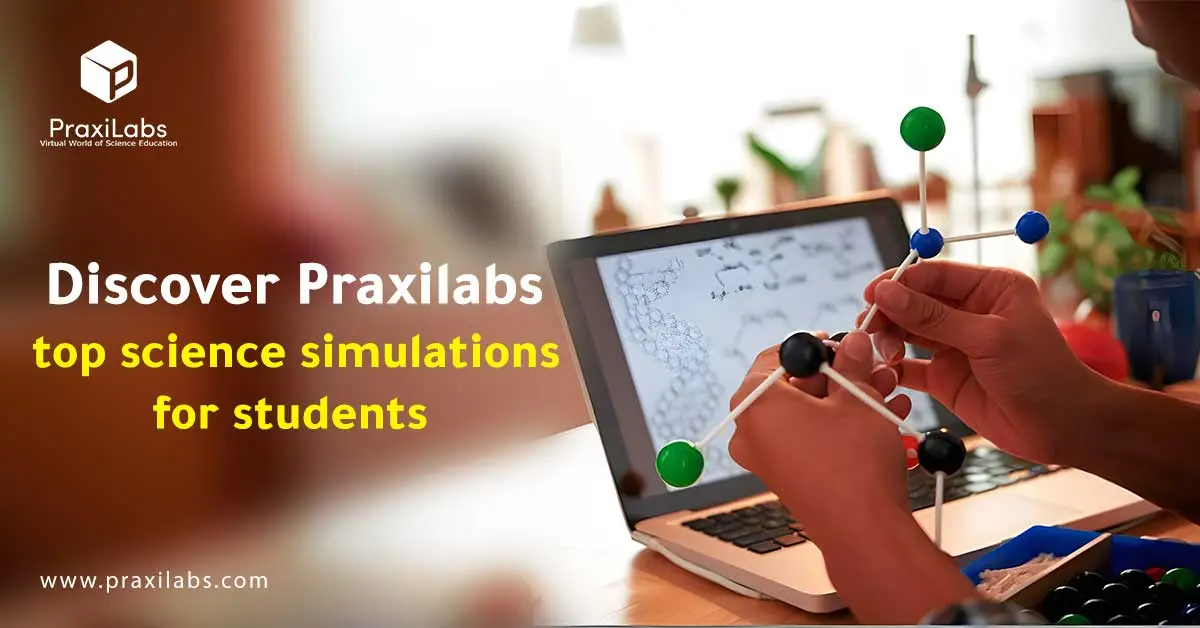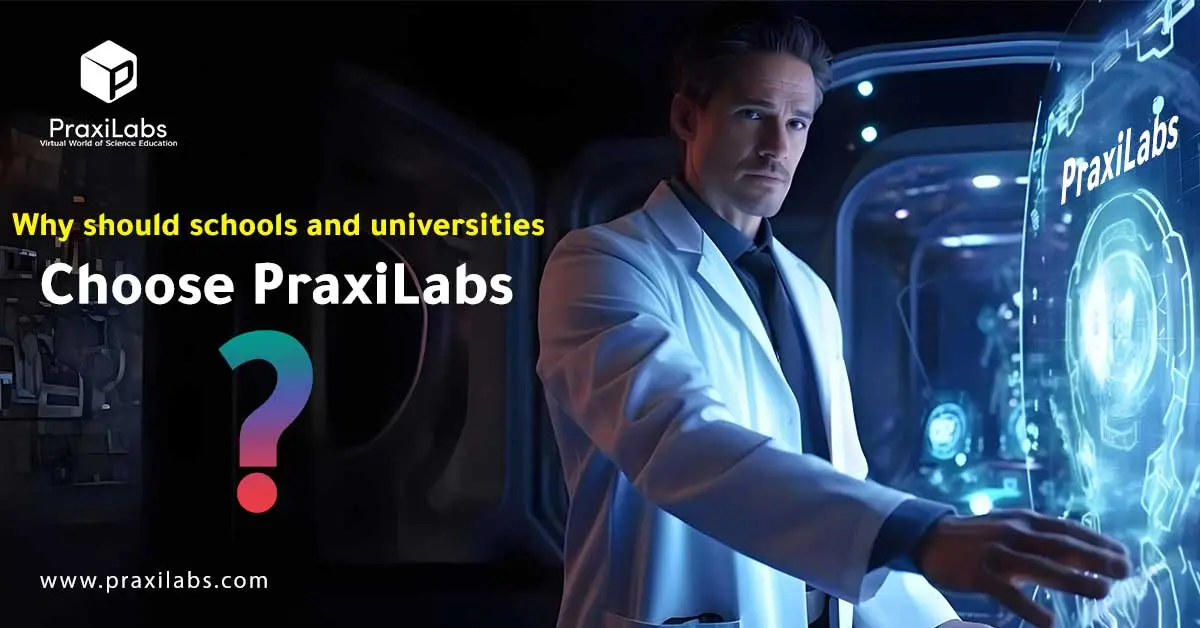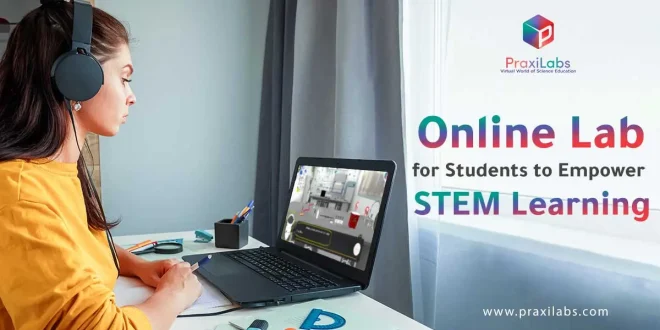Last Updated on July 27, 2025 by Nourhan Essam
Today’s students don’t need to be in a physical lab to run exciting experiments. An online lab for students brings science to life through interactive simulations that can be accessed anytime, anywhere.
Whether it’s chemistry, biology, or physics, these virtual labs let students explore concepts, practice procedures safely, and learn at their own pace.
Let’s dive into the key objectives of using an online lab for students, how an online lab for students supports STEM learning, how you can use it, and also discover Praxilabs’ top science simulations for students.
Table of Contents
What is an online lab for students?
An online lab for students is a digital and interactive simulation of a real-world lab environment that mimics everything in the real laboratories such as tools, equipment, chemicals and devices.
Online simulations for students help students understand scientific concepts and perform their experiments virtually anytime and anywhere in a very safe environment.
Key objectives of using online lab for students
- Improving learning experiences through interactive, immersive, and affordable virtual simulations.
- Fostering the development of essential scientific skills.
- Enhancing understanding of scientific concepts.
- Providing a safe and cost-effective environment for experimentation, and learn from mistakes.
How online lab for students support STEM learning?
STEM learning aims to enhance critical thinking skills, equip students with the skills and knowledge needed for success in the 21st-century workforce, and address real-world challenges.
By using an online lab experiments for students during STEM learning, they can learn and understand the theoretical subjects effectively, and also perform their experiments as many times as they need anytime and in a safe environment.
This helps them enhance their learning retention and outcomes, and so, equips students with the skills and knowledge needed for success in the 21st-century workforce.
How can you use virtual labs for students?
Virtual labs for students are created to help students understand and practice the scientific concepts they study in their curriculum in a safe, accessible, and often cost-effective way
Here’s a step-by-step guide for professors or instructors on how to use virtual labs for students:
Step 1: Detect and define your learning objectives (what will your students learn by using virtual labs).
Step 2: Choose an appropriate platform that provides virtual lab simulations for students aligned with your goals.
Step 3: Familiarize yourself with the virtual lab simulations, try them yourself, and prepare any learning materials you may need.
Step 4: Integrate the platform with your preferred Learning Management System (LMS) to follow up on your students’ performance.
Step 5: Provide access and instructions to students. Tell your students:
- Where to find the virtual lab.
- How to log in.
- How to use it.
- Deadline.
- Expectations for reports or quizzes.
Step 6: Collect and review students’ performance and Provide feedback to adjust for next semester.
PraxiLabs provides instant and unlimited access to several STEM simulations you may need from anywhere, without the hassle of going to the laboratory. Let your young scientists enjoy their journey, anytime!
Discover Praxilabs top science simulations for students

PraxiLabs develops interactive 3D virtual lab simulations in the fields of biology, chemistry, and physics.
Let’s discover Praxilabs’ top science simulations for students:-
Physics | Free fall
In this experiment your students are going to learn how to determine the uniform acceleration of a freely falling object due to gravity and validate the calculated gravitational acceleration (g) by determining the instantaneous velocity of the falling object.
By the end of free fall simulation, students will be able to:
- Measure the displacement of a freely falling object.
- Test the hypothesis that the acceleration of a freely falling object is uniform.
- Calculate the uniform acceleration of a falling object due to gravity (g).
- Determine the instantaneous velocity of the falling object.
Chemistry| Synthesis of Ethyl Propanoate via Fischer Esterification Reaction
The goal of this experiment is to synthesize Ethyl Propanoate by combining propanoic acid and ethanol in the presence of concentrated sulfuric acid.
By the end of the experiment, students will be able to:
- Become proficient at running organic chemical reactions.
- Learn the basics of organic synthesis procedures.
- Understand the mechanism of the Fischer esterification reaction.
- Learn the function of the Fischer esterification reaction.
- Get trained on how the separatory funnel is used.
Biology| Mitosis in Onion Roots
In this experiment, your students are going to study the different stages of mitosis by examining a temporary acetocarmine squash preparation of root-tip cells from an onion. This process is mainly used to observe and identify the different phases of cell division.
By the end of the experiment, students will be able to:
- Study and understand the different stages of mitosis.
- Identify the different phases of cell division.
Why should schools and universities choose PraxiLabs?

At PraxiLabs, our aim is to provide equal opportunity for an enhanced science education in biology, chemistry, and physics.
Let’s explore why PraxiLabs is the best:
3D Immersive Experience
Need to reach your set learning outcomes?
Get that and so much more! Give your students interactive 3D simulations of a realistic lab:
- Better time management.
- Better lab skills and knowledge.
- Cover your curriculum.
Practice-Centric Simulations
Control students’ learning and still give them the freedom they want! Repeat the same experiment over and over, watch the progress bar record, and get immediate feedback.
Save Time & Money with Free Science Lab-LMS Integration
Get your LMS smoothly integrated with our virtual science lab in just 24 hours, completely for free. Stay in charge and save your finance and IT teams’ effort, time, and money.
Bilingual
If you’re looking for higher education science lab experiments in English or Arabic, PraxiLabs will get you ready to go in no time! Need a simulation in a different language? We customize it upon request
Safe
Through PraxiLabs, students can gain a real-world understanding of the concepts and procedures without jeopardizing their safety or being exposed to harmful experiment effects.
Anytime, Anywhere
Students can access PraxiLabs anytime and anywhere according to their own pace and convenience.
Try PraxiLabs and Experience a Virtual World of Science Education
Pick the Best Virtual Plan or You
Frequently Asked Questions
What is the virtual lab, and how useful is it for a student?
Virtual lab is an interactive learning method that enables students to perform their experiments in a safe and controlled environment that simulates real laboratories. Students can learn and try anywhere and anytime for several times.
How can laboratory classes be done at home?
It can be done by using virtual lab simulations. You can help your students perform their experiments online and track their performance by using virtual simulations.
Should STEM programs be offered completely online with virtual labs?
It’s generally not recommended to offer them completely online without any in-person lab experiences.
 PraxiLabs A virtual world of science
PraxiLabs A virtual world of science






